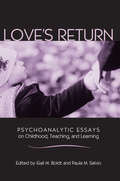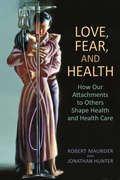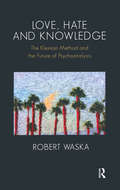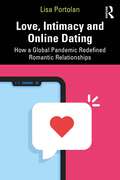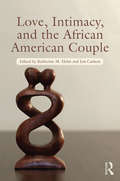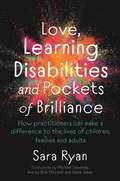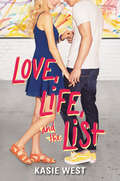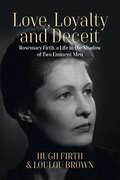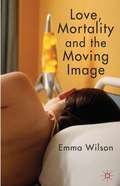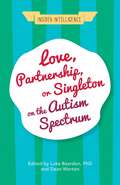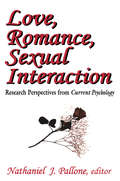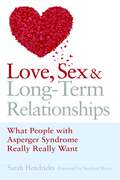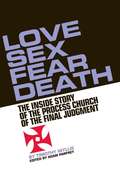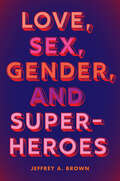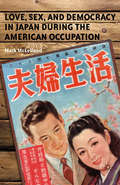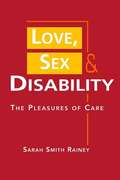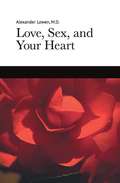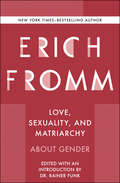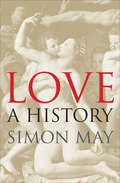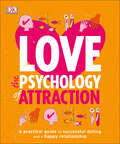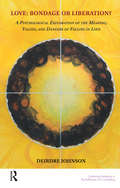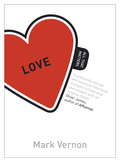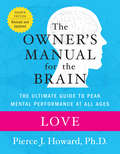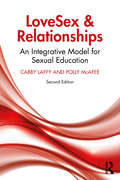- Table View
- List View
Love's Return: Psychoanalytic Essays on Childhood, Teaching, and Learning
by Paula M. Salvio Gail M. BoldtThe idea that teachers love children is often taken for granted in education. Rarely is the idea of love itself examined. Bringing together the work of educators, curriculum theorists and clinical psychoanalysts, and drawing upon autobiographical and narrative case studies, this groundbreaking collection examines the collision of love and learning, including the ways in which such intersections are provoked, repressed and denied. Contributors turn to psychoanalysis to explore questions of love in all of its varying permutations - ambivalence, sexuality, hatred, desire, projection, and loss - in order to demonstrate how the social ramifications of such work is critical to the ways teachers are currently being prepared for life in the classroom.
Love, Fear, and Health
by Robert Maunder Jonathan HunterCan the way in which we relate to others seriously affect our health? Can understanding those attachments help health care providers treat us better? In Love, Fear, and Health, psychiatrists Robert Maunder and Jonathan Hunter draw on evidence from neuroscience, stress physiology, social psychology, and evolutionary biology to explain how understanding attachment - the ways in which people seek security in their close relationships - can transform patient outcomes.Using attachment theory, Maunder and Hunter provide a practical, clinically focused introduction to the influence of attachment styles on an individual's risk of disease and the effectiveness of their interactions with health care providers. Drawing on more than fifty years of combined experience as health care providers, teachers, and researchers, they explain in clear language how health care workers in all disciplines can use this knowledge to meet their patients' needs better and to improve their health.
Love, Hate and Knowledge: The Kleinian Method and the Future of Psychoanalysis
by Robert WaskaThis book introduces the clinical concept of analytic contact. This is a term that describes the therapeutic method of investigation that makes up psychoanalytic treatment. The field has been in debate for decades regarding what constitutes psychoanalysis. This usually centers on theoretical ideals regarding analyzability, goals, or procedure and external criteria such as frequency or use of couch. Instead, the concept of analytic contact looks at what takes place with a patient in the clinical situation. Each chapter in this book follows a wide spectrum of cases and clinical situations where hard to reach patients are provided the best opportunity for health and healing through the establishment of analytic contact. This case material closely tracks each patient's phantasies, and transference mechanisms which work to either increase, oppose, embrace, or neutralize, analytic contact. In addition, the fundamental internal conflicts all patients struggle with between love, hate, and knowledge are represented by extensive case reports.
Love, Intimacy and Online Dating: How a Global Pandemic Redefined Romantic Relationships
by Lisa PortolanLove, Intimacy and Online Dating: How a Global Pandemic Redefined Romantic Relationships is an innovative work that explores the concept of intimacy during the COVID-19 pandemic. The book provides an overview of the online dating world and apps, the use of which gradually became common as the pandemic restricted people’s interaction in the physical world. The author’s extensive research conducted during the pandemic posits a comprehensive understanding of the individual’s motivation to join a dating app and explores its varied aspects. This thoroughly researched book explores the themes and elements of online dating and examines the users’ motivation for joining a dating app, for seeking intimacy as well as for self-presentation on the app. Portolan examines the underlying politics and role of infrastructure of dating apps and describes how gender, power, and intimacy intersect to create new intimacy phenomena. She also utilises her research to put forth the key concept of "Jagged Love", which describes a user’s cyclical relationship with dating apps during the pandemic, and the gap between a user’s act to seek familiar romantic narratives and the app’s inability to deliver against these ideas. The chapters further explore the differences between virtual and In Real Life (IRL) intimacy, the generation of gender and the emanation of stereotypical cultural ideals that the users sought through the apps. The book serves as an invaluable discussion on the pandemic’s impact on modifying the definitions of romance and intimacy. This book will be useful for highlighting the impact social factors can have on familiar concepts and the effects of the COVID-19 pandemic on the definition of love and intimacy, making it fascinating for students, academics and professionals interested in relationships, digital media and gender. It will also be useful in enhancing the comprehension of love and romance in the fields of social science.
Love, Intimacy, and the African American Couple (Routledge Series on Family Therapy and Counseling)
by Jon Carlson Katherine M. HelmThis exciting new text on counseling African American couples outlines critical components to providing culturally-sensitive treatment. Built around a framework that examines African American couples’ issues as well as the specific contextual factors that can negatively impact their relationships, it:• Addresses threats to love and intimacy for Black couples• Provides culturally relevant, strengths-based approaches and assessment practices• Includes interesting case studies at the conclusion of each chapter that illustrate important concepts.The chapters span the current state of couple relationships; readers will find information for working with lesbians and gays in relationships, pastoral counseling, and intercultural Black couples. There is also a chapter for non-Black therapists who work with Black clients. Dispersed throughout the book are interviews with prominent African American couples’ experts: Dr. Chalandra Bryant, relationship expert Audrey B. Chapman, Dr. Daryl Rowe and Dr. Sandra Lyons-Rowe, and Dr. Thomas Parham. They provide personal insight on issues such as the strengths African Americans bring to relationships, their skills and struggles, and gender and class considerations. This must-read book will significantly help you and your clients.
Love, Learning Disabilities and Pockets of Brilliance: How Practitioners Can Make a Difference to the Lives of Children, Families and Adults
by Sara RyanFind some pockets of brilliance for your practice! Insights and inspiration from families of learning disabled people, who share their lives, challenges and wishes. Discover what sorts of help will really help the people you support.
Love, Life, and the List
by Kasie WestWhat do you do when you’ve fallen for your best friend? Funny and romantic, this effervescent story about family, friendship, and finding yourself is perfect for fans of Sarah Dessen and Jenny Han.Seventeen-year-old Abby Turner’s summer isn’t going the way she’d planned. She has a not-so-secret but definitely unrequited crush on her best friend, Cooper. She hasn’t been able to manage her mother’s growing issues with anxiety. And now she’s been rejected from an art show because her work “has no heart.” So when she gets another opportunity to show her paintings, Abby isn’t going to take any chances.Which is where the list comes in.Abby gives herself one month to do ten things, ranging from face a fear (#3) to learn a stranger’s story (#5) to fall in love (#8). She knows that if she can complete the list, she’ll become the kind of artist she’s always dreamed of being.But as the deadline approaches, Abby realizes that getting through the list isn’t as straightforward as it seems . . . and that maybe—just maybe—she can’t change her art if she isn’t first willing to change herself.
Love, Loyalty and Deceit: Rosemary Firth, a Life in the Shadow of Two Eminent Men
by Hugh Firth Loulou BrownHow much do we really know about our parents’ lives? What secrets lie in plain sight? This is the true story of hidden love within a small circle of some of the most acclaimed anthropologists of the 20th century. Told by Rosemary and Raymond Firth's son, and the daughter of Celia and Edmund Leach, the man Rosemary loved all her life, this part love-story, part biography, part social history is the tale of a highly influential circle of social anthropologists in Britain from the 1930s, through the Second World War, to the end of the century. The book explores their early influences, their insecurities, their flaws, struggles and achievements. It is a story of passion and commitment, but also of deceit and betrayal, including the inexplicable disappearance, death and alleged murder of a very close friend. It also narrates Rosemary's struggles for emotional and intellectual independence in the face of societal expectations of women and her own guilt, loss and self-doubt. From the Prologue: Rosemary loved many people in many different ways, but she loved two men in particular throughout most of her life. One was her husband, Raymond Firth, regarded by some as among the founding fathers of social anthropology. Yet she also retained a passionate devotion to her first love, Edmund Leach, who would subsequently become the public intellectual face of social anthropology in the later 1960s. Both separately and together they were part of the process of defining the nature of this still growing discipline in the first part of the mid-twentieth century.
Love, Mortality and the Moving Image
by Emma WilsonIn their use of home movies, collages of photographs and live footage, moving image artists explore the wish to see dead loved ones living. This study scrutinizes emotions and sensations surrounding mortality and longing. Its focus is on love, tenderness, and eroticism, on the undoing of the self in desire and loss, and on the pursuit of relations with a missing other. In dialogue with Judith Butler on grievability, and Giorgio Agamben on bare life, Emma Wilsontraces connections between imaging of intimate losses and public acts of mourning in response to atrocity, the Shoah and Hurricane Katrina. The book lays out a series of sensitive new readings of works by Agnes Varda, Pedro Almodovar, Ingmar Bergman, Sophie Calle, and many others. Attending to images of tactility, to fine details of texture, light, and affect, it re-imagines the role of the sensuous in lens-based art. "
Love, Partnership, or Singleton on the Autism Spectrum
by David Walsh David Smith Alexandra Brown Christopher Wilson Dean Worton Luke Beardon Philip Bricher A. Nonny Mouse Alex Wilkinson Alyssa Aleksanian Anthony Sclafani Atul Movelis C. A. Smart Chris Stobart Elizabeth Wady Freddie Gwen Greenwood Joanna Treasure Joseph Edmonds Jules Lacey Kerr Lynette Marshall Norman Bridge P. J. Hughes Paul Wady Planet Autism Sandra Beale-Ellis Tracy Turner Wenn LawsonIn an immensely varied and thoughtful collection of true life reflections on love, marriage and the single life, 26 authors with autism share their experiences and knowledge about successful (and unsuccessful) relationships. Digging deep into the many and varying ways in which autism affects feelings and relationships with others, these honest and intelligent testimonies give the insider's perspective on love on the spectrum. Whether you're a serial dater, hopelessly romantic or happily single, these perceptive and often funny explorations shows how to make good choices, surmount bad ones, and live a good life.
Love, Romance, Sexual Interaction: Research Perspectives from "Current Psychology"
by Nathaniel PalloneThis volume brings together in a single resource fourteen empirical studies examining a variety of emotions and behaviors covering many aspects of love, romance, and sexual interaction from recent issues of Current Psychology. Scholars from universities and research centers bring under the empiricist's microscope a variety of emotions and behaviors, ranging from dating relationships, criteria for the ideal mate held by both men and women, the relationship between perceptions of parents and partners in a direct test of psychoanalytic conceptualizations of mate selection, how the media influence perceptions about love and romance, sources of marital conflict, gender differences in responses to infidelity, and even the attitudes of "consumers" toward prostitution.Contributors and topics of discussion include: Albert Mehrabian and Jeffrey S. Blum, "Physical Appearance, Attractiveness, and the Mediating Effect of Emotions"; Gordon L. Flett, Paul L. Hewitt, Brenley Shapiro, and Jill Rayman, "Perfectionism, Beliefs, and Adjustment in Dating Relationships"; Robert Ervin Cramer, Jeffrey T. Schaefer, and Suzanne Reid, "Identifying the Ideal Mate: More Evidence for Male-Female Convergence"; Glenn Geher, "Perceived and Actual Characteristics of Parents and Partners: A Freudian Model of Mate Selection"; Claudia J. Haferkamp, "Beliefs about Relationships in Relation to Television Viewing, Soap Opera Viewing, and Self-Monitoring"; Blaine J. Flowers and Brooks Applegate, "Marital Satisfaction and Conventionalization Examined Didactically"; Claudia J. Haferkamp, "Dysfunctional Beliefs, Self-Monitoring, and Marital Conflict"; Emily A. Impett, Kristin P. Beals, and Letitia A. Peplau, "Testing the Investment Model of Relationship Commitment and Stability in a Longitudinal Study of Married Couples"; Richard Clements and Clifford H. Swensen, "Commitment to One's Spouse as a Predictor of Marital Quality among Older Couples"; Robert Ervin Cramer, William Todd Abraham, Lesley M. Johnson, Barbara Manning-Ryan, "Gender Differences in Subjective Distress to Emotional and Sexual Infidelity"; William Todd Abraham, Robert Ervin Cramer, Ana Maria Fernandez, and Eileen Mahler, "Infidelity, Race, and Gender"; Ami Rokach, "Strategies of Coping with Loneliness throughout the Lifespan."
Love, Sex and Long-Term Relationships: What People with Asperger Syndrome Really Really Want
by Stephen Shore Sarah HendrickxWhat are the motivations and desires behind relationship choices and sexual behaviour? Are they very different for those with Asperger Syndrome (AS) than for anyone else? Does having extreme sensitivity to physical touch or an above average need for solitude change one's expectation of relationships or sexual experience? Many people on the autism spectrum have limited knowledge of how to establish or conduct sexual relationships: drawing on extensive research with people on the autism spectrum, the book openly explores such questions. For the first time people with AS discuss their desires, needs and preferences in their own words. AS attitudes to issues such as gender, sexual identity and infidelity are included, as well as positive advice for developing relationships and exploring options and choices for sexual pleasure. This accessible book is an invaluable source of information and support for those with Asperger Syndrome and couples in which one or both partners has Asperger Syndrome, as well as counsellors and health and social care professionals.
Love, Sex, Fear, Death
by Timothy Wyllie Adam ParfreyThe Process Church of the Final Judgment was the apocalyptic shadow side of the flower-powered '60s and perhaps the most notorious cult of modern times.Hundreds of black-cloaked devotees, often wearing a satanic "Goat of Mendes" and a swastika-like mandala, swept the streets of London, New York, Boston, Chicago, New Orleans, and Toronto, selling magazines and books with titles like Fear and Humanity is the Devil. And within the group's "Chapters," members would participate in "Midnight Meditations" beneath photographs of the Christ-like leader.Celebrities like Marianne Faithful, James Coburn, and Mick Jagger participated in Process publications, and Funkadelic, in its Maggot Brain album, reprinted Process' "Fear Issue."Process' "Death Issue" interviewed the freshly-imprisoned Charles Manson leading to conspiracy hysteria in such books as Ed Sanders' The Family and Maury Terry's The Ultimate Evil. A lawsuit against Sanders' Manson book led to the removal of its Process-themed chapter by Dutton.Love, Sex, Fear, Death is the shocking, surprising, and secretive inside story of The Process Church, which was later transformed into Foundation Faith of the Millennium, and most recently as the Utah-based animal sanctuary, Best Friends.Included will be text by Timothy Wyllie, a formative member of the Process and Foundation Faith organizations; interviews with other former Processeans; rare reproductions of Process magazines; never-before-seen photographs; and fascinating transcripts from holy books and legal actions.The special limited edition will be hardcover, signed, numbered, and slipcased, and it will include a facsimile edition of the notorious "Death Issue."
Love, Sex, Gender, and Superheroes: Photogenic French Literature And The Prehistory Of Cinematic Modernity
by Jeffrey A. BrownImpossibly muscular men and voluptuous women parade around in revealing, skintight outfits, and their romantic and sexual entanglements are a key part of the ongoing drama. Such is the state of superhero comics and movies, a genre that has become one of our leading mythologies, conveying influential messages about gender, sexuality, and relationships. Love, Sex, Gender, and Superheroes examines a full range of superhero media, from comics to films to television to merchandising. With a keen eye for the genre’s complex and internally contradictory mythology, comics scholar Jeffrey A. Brown considers its mixed messages. Superhero comics may reinforce sex roles with their litany of phallic musclemen and slinky femme fatales, but they also blur gender binaries with their emphasis on transformation and body swaps. Similarly, while most heroes have heterosexual love interests, the genre prioritizes homosocial bonding, and it both celebrates and condemns gendered and sexualized violence. With examples spanning from the Golden Ages of DC and Marvel comics up to recent works like the TV series The Boys, this study provides a comprehensive look at how superhero media shapes our perceptions of love, sex, and gender.
Love, Sex, and Democracy in Japan during the American Occupation
by Mark MclellandThis is the first book in English to examine, through material in the popular press, the radical changes that took place in Japanese ideas about sex, romance and male-female relations in the wake of Japan's defeat and occupation by Allied forces at the end of the Second World War.
Love, Sex, and Disability: The Pleasures of Care
by Sarah Smith RaineyRainey (women's studies, Bowling Green State U. , Ohio), whose late partner had multiple sclerosis, presents a study of relationships between disabled and nondisabled partners. Rather than dwell on popular culture and medical perspectives on such relationships, the author examines the complexities of care and sexual intimacy in pre-and post-disability couples in focus groups, in feminist, queer theory, and other postmodern frameworks. She concludes that feminist and disability activists/scholars need to develop new narratives that emphasize equality in such relationships. Methodological notes and an annotated list of the self-representations and articles analyzed are appended.
Love, Sex, and Your Heart
by Alexander LowenLove, Sex, and Your Heart elucidates how emotional life and physical being are one, mutually reflective as two sides of a coin.Emotional life is tied to physical being and physical health is dependent on emotional well-being. Alexander Lowen's insight into these powerful connections offers an innovative approach to cardiovascular health and the treatment of heart disease. Lowen examines the feeling of love as a physiological process in the body. When this process is frustrated, as in the case of heartbreak or isolation, especially during childhood, people suppress their pain by unconsciously rigidifying their chest muscles. This results in a chronic restriction of breathing, movement, and feeling. It is this tension that limits pleasure, and predisposes so many to heart disease. This book features the principles and therapeutic techniques to help people understand their fear of love, release chronic muscular tension, and become more loving. It is essential reading for health professionals and anyone interested in the health of the heart.
Love, Sexuality, and Matriarchy: About Gender
by Erich Fromm&“[A] fascinating collection of essays&” on the complicated relations between men and women from the New York Times–bestselling author of The Art of Loving (The New York Times Book Review). The renowned social psychologist delves deep into the fraught relationship between genders, drawing upon the influential insights of Bachofen, Freud, Marx, and Briffault. Not primarily interested in the existence of anatomical and biological differences between the sexes, Fromm instead analyzes how these differences have been made use of throughout human history. Drawing from Bachofen&’s Mother Right, Fromm expounds on how matriarchal and patriarchal social structures determine relations between the sexes in essential ways, and how they are shaped by the dominant orientation of the social character at any given time. He posits that the most important question concerning gender relations is which characterological orientation determines human relationships: love or hate, love of life or fascination with force. Thus, it will not be gender conflict that will determine humanity&’s future but whether we opt for love of life or love of death. &“As these essays show, Fromm was a wide-ranging thinker whose writings sometimes manifested brilliant insights or practical wisdom.&” —Kirkus Reviews
Love: A History
by Simon May&“What is love? May plunders Western poetry, philosophy and psychology to find answers . . . Thought-provoking stuff&” (The Sunday Telegraph). Love—unconditional, selfless, unchanging, sincere, and totally accepting—is worshipped today as the West&’s only universal religion. To challenge it is one of our few remaining taboos. In this path-breaking and superbly written book, philosopher Simon May does just that, dissecting our ideas of love and showing how they are the product of a long and powerful cultural heritage. Tracing over twenty-five hundred years of human thought and history, May shows how our idea of love developed from its Hebraic and Greek origins alongside Christianity until, during the last two centuries, &“God is love&” became &“love is God&”—so hubristic, so escapist, so untruthful to the real nature of love, that it has booby-trapped relationships everywhere with deluded expectations. Brilliantly, May explores the very different philosophers and writers, both skeptics and believers, who dared to think differently: from Aristotle&’s perfect friendship and Ovid&’s celebration of sex and &“the chase,&” to Rousseau&’s personal authenticity, Nietzsche&’s affirmation, Freud&’s concepts of loss and mourning, and boredom in Proust. Against our belief that love is an all-powerful solution to finding meaning, security, and happiness in life, May reveals with great clarity what love actually is—and what it means. &“The most persuasive account of love&’s nature I have ever read.&” —Financial Times &“Intellectually engaging . . . Provocative.&” —The Wall Street Journal
Love: A Practical Guide to Successful Dating and a Happy Relationship
by DKLove: The Psychology of Attraction is an easy-to-navigate, step-by-step guide to modern love that's grounded in scientific study, psychological expertise, and practical insights about romance in the age of social media.Crack the code of compatibility and find the path to true love with this unique guide to finding the perfect mate in the modern world. Love: The Psychology of Attraction offers answers to your burning questions: How should I present myself online? What are red flags in a first phone call? Is it time to meet family members? And, it answers some unexpected questions, too: Is chemistry predictable? Do I have a "lifestyle type"?With every quiz, assessment, and inviting infographic, Love: The Psychology of Attraction guides you toward deeper, more satisfying relationships that can lead to long-term fulfillment.
Love: A Psycholological Exploration of the Meaning, Values and Dangers of Falling in Love (The\united Kingdom Council For Psychotherapy Ser.)
by Deirdre JohnsonMuch has been written about the function of falling in love in the course of therapy itself. This book has a much broader aim. The author, a Jungian analyst and psychotherapy trainer, uses her teaching and clinical experience to illuminate the whole range of this near universal human experience. How, and why, does falling in love affect us so profoundly? How can it enhance who we are, or must it ultimately fade without lasting value? The author argues that the many valuable studies by psychoanalysts, relational psychologists, anthropologists, neuroscientists, and philosophers have all made valuable contributions, and uses these to highlight and explore the many values and dangers inherent in passionate love. However, she claims that a more holistic approach is required to show how these various accounts can be seen as complementary rather than competing, and can be accommodated within an overarching view of the integration of the human being in its heights and depths.
Love: All That Matters
by Mark VernonLove: All That Matters argues that the modern view on love has been distorted by a fixation on romantic love that has depleted our resources for living through the darker sides of love, whereas in fact there are several ways in which humans give and experience love over the course of their lives and it is best to have access to them all.Vernon draws on science, psychology, philosophy and literature, to examine eight different kinds of love, each associated with a phase of human development. From infant narcissism and the emergence of eros, through puberty and the rush of romantic love, to the end of life and the love of God, this is a beguiling tour of the most mysterious force of all.This accessible and readable book will appeal to both students and general readers, giving a fascinating introduction to the psychology and philosophy of love - and what matters most about it.
Love: All That Matters (All That Matters)
by Mark VernonLove: All That Matters argues that the modern view on love has been distorted by a fixation on romantic love that has depleted our resources for living through the darker sides of love, whereas in fact there are several ways in which humans give and experience love over the course of their lives and it is best to have access to them all.Vernon draws on science, psychology, philosophy and literature, to examine eight different kinds of love, each associated with a phase of human development. From infant narcissism and the emergence of eros, through puberty and the rush of romantic love, to the end of life and the love of God, this is a beguiling tour of the most mysterious force of all.This accessible and readable book will appeal to both students and general readers, giving a fascinating introduction to the psychology and philosophy of love - and what matters most about it.
Love: The Owner's Manual
by Pierce HowardCutting-edge, user-friendly, and comprehensive: the revolutionary guide to the brain, now fully revised and updatedAt birth each of us is given the most powerful and complex tool of all time: the human brain. And yet, as we well know, it doesn't come with an owner's manual--until now. In this unsurpassed resource, Dr. Pierce J. Howard and his team distill the very latest research and clearly explain the practical, real-world applications to our daily lives. Drawing from the frontiers of psychology, neurobiology, and cognitive science, yet organized and written for maximum usability, The Owner's Manual for the Brain, Fourth Edition, is your comprehensive guide to optimum mental performance and well-being. It should be on every thinking person's bookshelf. What are the ingredients of happiness? Which are the best remedies for headaches and migraines? How can we master creativity, focus, decision making, and willpower? What are the best brain foods? How is it possible to boost memory and intelligence? What is the secret to getting a good night's sleep? How can you positively manage depression, anxiety, addiction, and other disorders? What is the impact of nutrition, stress, and exercise on the brain? Is personality hard-wired or fluid? What are the best strategies when recovering from trauma and loss? How do moods and emotions interact? What is the ideal learning environment for children? How do love, humor, music, friendship, and nature contribute to well-being? Are there ways of reducing negative traits such as aggression, short-temperedness, or irritability? What is the recommended treatment for concussions? Can you delay or prevent Alzheimer's and dementia? What are the most important ingredients to a successful marriage and family? What do the world's most effective managers know about leadership, motivation, and persuasion? Plus 1,000s more topics!
LoveSex and Relationships: An Integrative Model for Sexual Education
by Cabby Laffy Polly McAfeeLoveSex and Relationships introduces a pleasure-focused rather than reproductive model of sex, exploring how our brains, minds, bodies and emotions interact to create our experience of sexuality. This book challenges the cultural commodification of sex and sexuality, and it encourages the reader to experience ‘being sexual’ rather than ‘doing sex’ or ‘looking sexy’. This is crucial to our development of sexual selfesteem, particularly in the digital era of pornography, dating and hookup apps. Bringing the material of the first edition up to date, chapters include anatomical diagrams and social commentary with a focus on trauma and Polyvagal Theory. Diversity and cultural changes are also addressed, including a more expansive understanding of gender identity, and greater awareness of the impact of power and rank in sexual relationships. Lastly, each chapter features a new partnered exercise alongside every solo exercise from the first edition. The book’s accessible language makes it a valuable resource for sex and relationship therapists and trainees, general mental health and sex/relationship professionals, and clients themselves.
